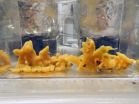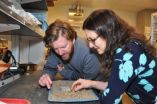(Press-News.org) WASHINGTON D.C. Feb. 17, 2014 -- Alzheimer's disease has long been marked by progress -- but not the kind of progress the medical community seeks. It is the most common form of dementia among older Americans, and its risk increases with increasing age; for those living with the disease, its ravages get worse over time; and as we move into the 21st century, it will place a greater and greater burden on society. The number of Americans living with Alzheimer's has doubled since 1980 and is expected to triple again by 2050.
Sadly, Alzheimer's disease has been the least prone to progress in the one area where we'd like to find change the most -- in our ability to fight it. There is still no way to prevent, reverse or definitively diagnose Alzheimer's disease using molecular markers or imaging.
Many research groups are working to change that, and at the 58th Annual Biophysical Society Meeting, which is taking place in San Francisco from Feb. 15-19, Giuseppe Melacini of McMaster University in Ontario, Canada will describe the progress his team is making at unraveling the mystery of the amyloid beta ("Abeta") peptide, a tangling molecule found in the brain plaques associated with the disease.
"By focusing on one of the main components that impairs proper brain function, called Abeta peptide, we are trying to understand what properties of Abeta lead to toxic aggregates implicated in brain impairment," explained Giuseppe Melacini. This work is significant, he added, because without a molecular understanding of Alzheimer's disease, it will be difficult if not impossible to begin to find a cure.
Melacini and his team used a unique method originally developed to study long-range communication in folded proteins. This is a new approach never used before for unfolded peptides, such as the Abeta molecule, and it could reveal transient elusive states of Abeta that have escaped detection so far but that could be implicated in toxic aggregate formation. The research team dealt with challenges unique to the Abeta molecule. This system is difficult to work with because it is very aggregation prone and very sensitive to even the smallest differences in sample preparation protocols, says Melacini. "The Abeta molecule is also highly dynamic and it is therefore hard to pinpoint which structures out of this complex ensemble are functionally relevant."
While this research is still in its early stages, the team is taking the next steps to identify Abeta structures that either form or inhibit the formation of toxic aggregates, which in turn can cause brain impairment. Once that is done, the goal will be to trap these structures and use them for screening.
"If we can identify the structures of the Abeta peptide that lead to toxic aggregates, we can then begin the development of inhibitors to suppress that process and have a chance to find treatments for Alzheimer's disease," Melacini said.
INFORMATION:
The presentation "Finding Order in Disorder: Probing Transient Functional States in the Amyloidogenic Alzheimer's Aβ Peptide Using the NMR Chemical Shift Covariance Analysis (CHESCA)" by Moustafa Algamal, Julijana Milojevic, Naeimeh Jafari, Shiyuan Zhang, Rajeevan Selvaratnam and Giuseppe Melacini will be at 11:45 a.m. on Monday, February 17, 2014 in Room 304 in San Francisco's Moscone Convention Center. ABSTRACT: http://tinyurl.com/nljg2o3
ABOUT THE MEETING
Each year, the Biophysical Society Annual Meeting brings together more than 7,000 researchers working in the multidisciplinary fields representing biophysics. With more than 4,200 poster presentations, over 200 exhibits, and more than 20 symposia, the BPS Annual Meeting is the largest meeting of biophysicists in the world. Despite its size, the meeting retains its small-meeting flavor through its subgroup symposia, platform sessions, social activities, and committee programs.
The 58th Annual Meeting will be held at the Moscone Convention Center, 747 Howard Street, San Francisco, California.
PRESS REGISTRATION
The Biophysical Society invites professional journalists, freelance science writers and public information officers to attend its Annual Meeting free of charge. For press registration, contact Alisha Yocum at ayocum@biophysics.org or Jason Bardi at 240-535-4954.
QUICK LINKS
Main Meeting Page: http://tinyurl.com/mfjh37p
Program Highlights: http://tinyurl.com/mosxrof
Abstracts Search: http://tinyurl.com/lbrearu
ABOUT THE SOCIETY
The Biophysical Society, founded in 1958, is a professional, scientific Society established to encourage development and dissemination of knowledge in biophysics. The Society promotes growth in this expanding field through its annual meeting, monthly journal, and committee and outreach activities. Its 9000 members are located throughout the U.S. and the world, where they teach and conduct research in colleges, universities, laboratories, government agencies, and industry. For more information on the Society, or the 2014 Annual Meeting, visit http://www.biophysics.org
Finding ways to detect and treat Alzheimer's disease
Canadian researchers are unraveling the mysteries of the amyloid beta peptides, implicated in Alzheimer's disease, which they describe at Biophysical Society Meeting
2014-02-18
ELSE PRESS RELEASES FROM THIS DATE:
Annals of Internal Medicine tip sheet for Feb. 18, 2014
2014-02-18
1. Aortic valve replacement improves function but may not improve quality of life
Transcatheter aortic valve replacement (TAVR) improves functional status but may not improve overall quality of life, according to an article being published in Annals of Internal Medicine. Aortic stenosis (AS) is the most common valvular heart disease in developing countries and it affects up to 3 percent of adults older than 75. In recent years, TAVR has emerged as an alternative treatment to surgical aortic valve replacement (SAVR) for high-risk or inoperable patients with symptomatic ...
Stress hormones in traders may trigger 'risk aversion' and contribute to market crises
2014-02-18
High levels of the stress hormone cortisol may contribute to the risk aversion and 'irrational pessimism' found among bankers and fund managers during financial crises, according to a new study.
The study's authors say that risk takers in the financial world exhibit risk averse behaviour during periods of extreme market volatility – just when a crashing market most needs them to take risks – and that this change in their appetite for risk may be "physiologically-driven", specifically by the body's response to cortisol. They suggest that stress could be an "under-appreciated" ...
How well do football helmets protect players from concussions?
2014-02-18
PHILADELPHIA – A new study finds that football helmets currently used on the field may do little to protect against hits to the side of the head, or rotational force, an often dangerous source of brain injury and encephalopathy. The study released today will be presented at the American Academy of Neurology's 66th Annual Meeting in Philadelphia, April 26 to May 3, 2014.
"Protection against concussion and complications of brain injury is especially important for young players, including elementary and middle school, high school and college athletes, whose still-developing ...
How evolution shapes the geometries of life
2014-02-18
Why does a mouse's heart beat about the same number of times in its lifetime as an elephant's, although the mouse lives about a year, while an elephant sees 70 winters come and go? Why do small plants and animals mature faster than large ones? Why has nature chosen such radically different forms as the loose-limbed beauty of a flowering tree and the fearful symmetry of a tiger?
These questions have puzzled life scientists since ancient times. Now an interdisciplinary team of researchers from the University of Maryland and the University of Padua in Italy propose a thought-provoking ...
Theory on origin of animals challenged: Animals needs only extremely little oxygen
2014-02-18
One of science's strongest dogmas is that complex life on Earth could only evolve when oxygen levels in the atmosphere rose to close to modern levels. But now studies of a small sea sponge fished out of a Danish fjord shows that complex life does not need high levels of oxygen in order to live and grow.
The origin of complex life is one of science's greatest mysteries. How could the first small primitive cells evolve into the diversity of advanced life forms that exists on Earth today? The explanation in all textbooks is: Oxygen. Complex life evolved because the atmospheric ...
Researchers warn against abrupt stop to geoengineering method
2014-02-18
As a range of climate change mitigation scenarios are discussed, University of Washington researchers have found that the injection of sulfate particles into the atmosphere to reflect sunlight and curb the effects of global warming could pose a severe threat if not maintained indefinitely and supported by strict reductions in greenhouse gas (GHG) emissions.
The new study, published today, 18 February, in IOP Publishing's journal Environmental Research Letters, has highlighted the risks of large and spatially expansive temperature increases if solar radiation management ...
First biological marker for major depression could enable better diagnosis and treatment
2014-02-18
Teenage boys who show a combination of depressive symptoms and elevated levels of the 'stress hormone' cortisol are up to fourteen times more likely to develop major depression than those who show neither trait, according to research funded by the Wellcome Trust.
In a study published today in the Proceedings of the National Academy of Sciences, researchers from the University of Cambridge have identified the first biomarker – a biological signpost – for major, or clinical, depression. They argue that this could help identify those boys in particular at greatest risk ...
Why tackling appetite could hold the key to preventing childhood obesity
2014-02-18
A heartier appetite is linked to more rapid infant growth and to genetic predisposition to obesity, according to two papers published in JAMA Pediatrics today (Monday).
The studies investigated how weight gain is linked to two key aspects of appetite, namely lower satiety responsiveness (a reduced urge to eat in response to internal 'fullness' signals) and higher food responsiveness (an increased urge to eat in response to the sight or smell of nice food).
The first paper reveals that infants with a heartier appetite grew more rapidly up to age 15 months, potentially ...
Ancient herring catch nets fisheries weakness
2014-02-18
Archaeological data indicate modern herring management needs to take a longer look into the past to manage fisheries for the future says a new study involving Simon Fraser University researchers.
That is one of the key findings in the study, just published online in Proceedings of the National Academy of Sciences (PNAS). SFU researchers Iain McKechnie, Dana Lepofsky and Ken Lertzman, and scientists in Ontario, Alberta and the United States are its co-authors.
The study is one of many initiatives of the SFU-based Herring School, a group of researchers that investigates ...
'It takes a village' -- Community-based methods for improving maternal and newborn health
2014-02-18
A series of studies are published in a special supplement that presents results of the Maternal and Newborn Health in Ethiopia Partnership—a three-year pilot program funded by the Bill & Melinda Gates Foundation with the goal of improving the health of Ethiopian mothers and their newborns. This special issue of the Journal of Midwifery & Women's Health is published by Wiley on behalf of the American College of Nurse-Midwives.
High mortality rates for pregnant women and newborns continue to be a major health concern in Africa, with Ethiopia being one of the most affected ...
LAST 30 PRESS RELEASES:
Tracing the quick synthesis of an industrially important catalyst
New software sheds light on cancer’s hidden genetic networks
UT Health San Antonio awarded $3 million in CPRIT grants to bolster cancer research and prevention efforts in South Texas
Third symposium spotlights global challenge of new contaminants in China’s fight against pollution
From straw to soil harmony: International team reveals how biochar supercharges carbon-smart farming
Myeloma: How AI is redrawing the map of cancer care
Manhattan E. Charurat, Ph.D., MHS invested as the Homer and Martha Gudelsky Distinguished Professor in Medicine at the University of Maryland School of Medicine
Insilico Medicine’s Pharma.AI Q4 Winter Launch Recap: Revolutionizing drug discovery with cutting-edge AI innovations, accelerating the path to pharmaceutical superintelligence
Nanoplastics have diet-dependent impacts on digestive system health
Brain neuron death occurs throughout life and increases with age, a natural human protein drug may halt neuron death in Alzheimer’s disease
SPIE and CLP announce the recipients of the 2025 Advanced Photonics Young Innovator Award
Lessons from the Caldor Fire’s Christmas Valley ‘Miracle’
Ant societies rose by trading individual protection for collective power
Research reveals how ancient viral DNA shapes early embryonic development
A molecular gatekeeper that controls protein synthesis
New ‘cloaking device’ concept to shield sensitive tech from magnetic fields
Researchers show impact of mountain building and climate change on alpine biodiversity
Study models the transition from Neanderthals to modern humans in Europe
University of Phoenix College of Doctoral Studies releases white paper on AI-driven skilling to reduce burnout and restore worker autonomy
AIs fail at the game of visual “telephone”
The levers for a sustainable food system
Potential changes in US homelessness by ending federal support for housing first programs
Vulnerability of large language models to prompt injection when providing medical advice
Researchers develop new system for high-energy-density, long-life, multi-electron transfer bromine-based flow batteries
Ending federal support for housing first programs could increase U.S. homelessness by 5% in one year, new JAMA study finds
New research uncovers molecular ‘safety switch’ shielding cancers from immune attack
Bacteria resisting viral infection can still sink carbon to ocean floor
Younger biological age may increase depression risk in older women during COVID-19
Bharat Innovates 2026 National Basecamp Showcases India’s Most Promising Deep-Tech Ventures
Here’s what determines whether your income level rises or falls
[Press-News.org] Finding ways to detect and treat Alzheimer's diseaseCanadian researchers are unraveling the mysteries of the amyloid beta peptides, implicated in Alzheimer's disease, which they describe at Biophysical Society Meeting



